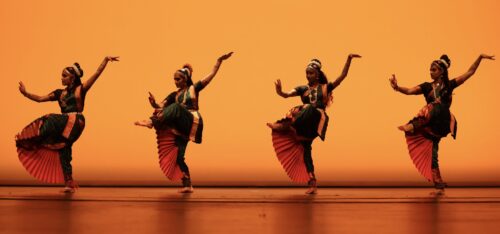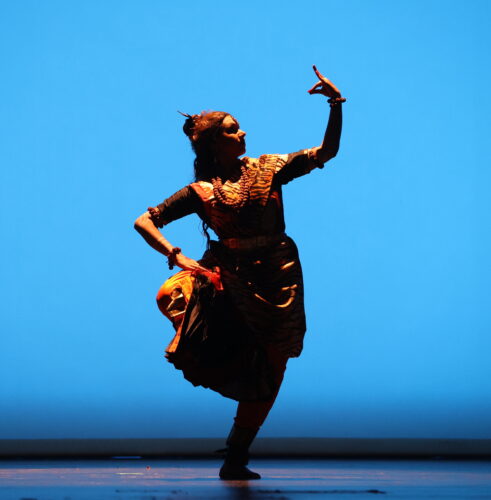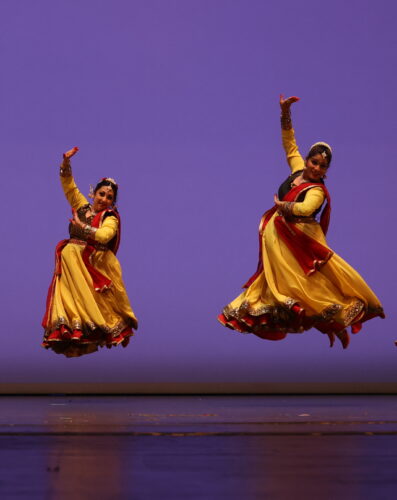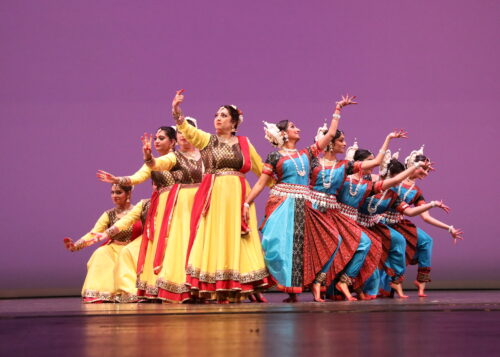Silambam Showcases the Diversity of Classical Indian Dance through the Cosmos

Photos by Amitava Sarkar
The more I write about dance, and think about dance, the more I realize how much dance has always been present in major moments of my life, even forms that are outside of my own practice. Eleven years ago I spent five-and-a-half months backpacking through India, attempting to read, journal, and experience my way into a new chapter of existence. About two months in, a friend I picked up in Goa and I went to see a kathakali performance, a classical Indian dance form that is unique in its striking make-up, ornate headpieces, and large-scale wardrobe. For me, this was a highlight of my journey, one that inspired me to focus on dance studies when I returned to Houston.
The term classical Indian dance does not refer to a singular style or vocabulary. Rather, it encompasses several dance forms that originate in the Hindu devotional tradition. The majority of these forms were danced in temples and expressed religious narratives. Each dance developed in a distinct region of India, and was shaped by the customs and traditions of its people; kathakali, for example, comes from Kerala in the south of India, while Kathak comes from Uttar Pradesh in the north.
 In my experience, while the classical Indian dances have similarities in theme and intention, the movement and stylization of hand and facial gestures render them strikingly different from one another. This is why I was excited to see Dance of the Cosmos, produced by Silambam Houston for the Miller Outdoor Theatre stage on June 3, 2022. Conceived and directed by Silambam’s Executive Artistic Director Lavanya Rajagopalan, Dance of the Cosmos featured four classical Indian dance styles: Bharatanatyam, Kathak, Odissi, and Kuchipudi.
In my experience, while the classical Indian dances have similarities in theme and intention, the movement and stylization of hand and facial gestures render them strikingly different from one another. This is why I was excited to see Dance of the Cosmos, produced by Silambam Houston for the Miller Outdoor Theatre stage on June 3, 2022. Conceived and directed by Silambam’s Executive Artistic Director Lavanya Rajagopalan, Dance of the Cosmos featured four classical Indian dance styles: Bharatanatyam, Kathak, Odissi, and Kuchipudi.
The concert opened with “Rhythms of the Universe (Nandichol),” which introduced each of the four ensembles. The work juxtaposed the four styles with smart, well-staged choreography that highlighted the differences between the traditions, while also magnifying the beauty of each form. The soft, billowing movement of Kathak was contrasted with the sharp precision of Bharatanatyam, while the fluid, water-like quality of Odissi was set against the pulsating energy of Kuchipudi. The tableau of the four ensembles in repose, with only the hands moving in varied tempos, qualities, and gestures according to their respective traditions, was quite beautiful and hinted at the richness of dancing to come.
“The Cosmic Dancer (Shiva Thandava Stotram)” was the next full cast work that again featured all four styles. The four ensembles were accompanied onstage by a soloist representing Shiva, one of the most prominent figures of the Hindu pantheon. The soloist, who appropriately commanded the stage, interacted with each ensemble, which I thought was a great choreographic choice that also added a bit of cultural context. All of these dances, after all, were danced for Shiva in temples across India.
 Rajagopalan uses the four classical dances to illustrate the symbolism evoked by Shiva, namely, the duality of creation and destruction, the binary of masculine and feminine energies, and the elements of earth, water, fire, air, and space. In a suite of dances in the middle of the program, each dance is used to personify one of the five elements. I thought the pairings were thoughtful, and made use of the qualities inherent in each dance. For example, it made sense to have Kathak illustrate air, as the dance frequently makes use of whirling turns, dovelike hand sequences, and soft, almost imperceptible footwork. The dance is also traditionally dressed in long skirts, which give the impression of flight when the choreography really picks up and moves.
Rajagopalan uses the four classical dances to illustrate the symbolism evoked by Shiva, namely, the duality of creation and destruction, the binary of masculine and feminine energies, and the elements of earth, water, fire, air, and space. In a suite of dances in the middle of the program, each dance is used to personify one of the five elements. I thought the pairings were thoughtful, and made use of the qualities inherent in each dance. For example, it made sense to have Kathak illustrate air, as the dance frequently makes use of whirling turns, dovelike hand sequences, and soft, almost imperceptible footwork. The dance is also traditionally dressed in long skirts, which give the impression of flight when the choreography really picks up and moves.
A wonderful moment in the evening was at the closing of the space element, which made use of the full company. The four ensembles, staged in separate quadrants of the stage, dissolve and the dancers move in slow, detailed sequences into one another. The four elements become the final fifth element and the lights go down on the now intermingled composition of Bharatanatyam, Kathak, Odissi, and Kuchipudi dancers.
 Perhaps the most fully realized work on the program was “Nagendra Haaraya,” performed by the Odissi ensemble. The round, circular vocabulary was danced with gorgeous fluidity, and the choreography was filled with majestic half-moon shapes and patterns that filled the entire stage. I’m not sure how this particular piece was rehearsed, but the dancers here paid particular attention to detail in both bodily and facial articulations. The Odissi ensemble had expressed the water element in the previous section, but even though the group was still costumed and lighted in blues, their expression in this dance felt grounded and especially mindful. This focused energy lent itself to the spiritual valence that the classical Indian forms spring from, and was satisfying as a repertory piece in and of itself.
Perhaps the most fully realized work on the program was “Nagendra Haaraya,” performed by the Odissi ensemble. The round, circular vocabulary was danced with gorgeous fluidity, and the choreography was filled with majestic half-moon shapes and patterns that filled the entire stage. I’m not sure how this particular piece was rehearsed, but the dancers here paid particular attention to detail in both bodily and facial articulations. The Odissi ensemble had expressed the water element in the previous section, but even though the group was still costumed and lighted in blues, their expression in this dance felt grounded and especially mindful. This focused energy lent itself to the spiritual valence that the classical Indian forms spring from, and was satisfying as a repertory piece in and of itself.
Dance of the Cosmos was a lovely evening that brought to life the central tenants of Hinduism through four classical Indian dances. Voice over was provided to introduce each section, but I’m sure the work would have been just as successful without the exposition. The choreography, and its ancient movement vocabulary that has transcended the parameters of time and geography, spoke for itself.



Recent Comments